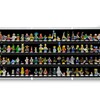Portable Fire Monitors: High-Performance, Mobile Firefighting Solutions
Firefighting in dynamic, hazardous, and large-scale industrial environments requires flexible and high-capacity solutions. One such critical component is the Portable Fire Monitor—a powerful, mobile device that delivers high volumes of water or foam to suppress fires in areas where fixed systems are unavailable or inadequate.
From oil refineries and chemical storage depots to airports and marine docks, portable fire monitors play a vital role in enhancing firefighting efficiency and coverage. Their ability to be quickly deployed, adjusted, and relocated makes them indispensable tools for fire brigades, emergency response teams, and industrial safety operations.
What Is a Portable Fire Monitor?
A Portable Fire Monitor is a manually operated, ground-based nozzle device designed to project high volumes of water or firefighting foam at significant distances. Unlike fixed monitors which are permanently mounted, portable monitors are lightweight and mobile, allowing them to be quickly deployed and repositioned based on the fire’s behavior and location.
These monitors can be carried by one or two people and set up in minutes, making them especially useful in emergency situations or remote locations where fixed firefighting infrastructure is limited.
Key Features of Portable Fire Monitors
1. High Flow Rates
Most portable fire monitors are engineered to handle flow rates from 500 to 2,500 liters per minute (LPM), though some high-capacity models can exceed 3,000 LPM. This makes them capable of suppressing intense fires, especially those involving flammable liquids.
2. Long Projection Distance
Depending on the nozzle type and operating pressure, portable monitors can achieve a range of 30 to 70 meters (100 to 230 feet) or more, enabling safe and effective firefighting from a distance.
3. Adjustable Nozzles
Equipped with fog, jet, or combination nozzles, these devices allow operators to select the desired spray pattern—straight stream for long-range reach, or fog pattern for wider coverage and heat shielding.
4. Swivel and Elevation Control
Typically, portable monitors allow:
- 360° horizontal rotation
- Up to 90° vertical movement
This ensures full directional flexibility for targeting the fire accurately.
5. Sturdy Base for Stability
Portable monitors usually have foldable legs, rubber feet, or ground stakes to maintain stability under high pressure, preventing movement due to water reaction forces.
Components of a Portable Fire Monitor
|
Component
|
Function
|
|
Inlet connection
|
Attaches to fire hose or water supply
|
|
Nozzle
|
Controls stream pattern and flow direction
|
|
Swivel joints
|
Allow directional aiming (horizontal & vertical)
|
|
Control handles
|
For manual adjustment of direction and elevation
|
|
Ground base
|
Ensures monitor remains stable during operation
|
|
Pressure gauge
|
Monitors inlet pressure (optional but recommended)
|
Types of Portable Fire Monitors
1. Manually Operated Ground Monitors
These are compact, tripod or quad-legged monitors that are set on the ground and manually aimed. Lightweight and fast to deploy, they’re ideal for mobile fire units and first responders.
2. Trailer-Mounted Monitors
Larger portable units mounted on a small wheeled trailer. These offer higher flow rates and are suited for industrial sites with large open areas.
3. Backpack-Portable Monitors
Some specialized monitors are compact enough to be carried in a backpack and assembled on-site. These are suitable for remote areas such as forests or rugged terrains.
Applications of Portable Fire Monitors
Portable monitors are versatile and used across multiple sectors:
✅ Industrial Facilities
- Refineries, petrochemical plants, and storage terminals use portable monitors to cover high-risk zones quickly when a fire breaks out.
✅ Airports
- Ideal for use on runways, hangars, and aviation fuel storage areas where mobile response is critical.
✅ Marine and Offshore
- Docks, ports, and ships utilize portable monitors for onboard firefighting or to suppress fires on adjacent vessels or cargo.
✅ Municipal Fire Departments
- Fire trucks may carry portable monitors to supplement onboard systems or access difficult terrain.
✅ Forestry and Wildland Firefighting
- Backpack-deployable monitors help establish mobile water attack points in forests or remote fire lines.
Advantages of Portable Fire Monitors
✅ Rapid Deployment
Can be carried and set up by one or two operators within minutes—ideal in emergencies or unpredictable environments.
✅ Mobility
Easily moved to different fire zones during operations, especially useful when the fire shifts or spreads.
✅ High Efficiency
Delivers large volumes of extinguishing media to the target area faster than hand-held nozzles or hose lines alone.
✅ Minimal Manpower Requirement
Once deployed and aimed, they can operate with minimal supervision, freeing up firefighters for other tasks.
✅ Cost-Effective
Portable monitors are less expensive than fixed systems and do not require permanent installation or infrastructure.
Limitations to Consider
- Stability can be an issue at high flow rates without proper ground anchoring.
- Requires hose connection and pressurized water source nearby.
- Manual operation only, so continuous supervision may be needed for adjustment.
- Shorter range and lower flow compared to large fixed or truck-mounted monitors.
Installation and Operation
✔ Deployment Tips:
- Choose stable, level ground.
- Spread legs or stabilize base to counteract recoil.
- Connect to hose and test for leaks.
- Adjust nozzle pattern based on type of fire.
- Anchor or stake monitor if used on slopes or under high pressure.
✔ Safety Precautions:
- Never stand directly behind the monitor during operation (recoil hazard).
- Wear PPE (Personal Protective Equipment) at all times.
- Monitor hose couplings and pressure gauges regularly.
Maintenance Guidelines
Like all firefighting equipment, regular inspection and servicing of portable monitors is critical:
???? After Each Use
- Clean the nozzle, base, and swivel joints.
- Flush with clean water if foam was used.
- Check for visible damage or leaks.
???? Monthly Inspections
- Lubricate moving parts and control handles.
- Inspect seals, gaskets, and locking mechanisms.
- Check all couplings and inlet threads for wear.
???? Annual Maintenance
- Perform full pressure test.
- Replace worn-out parts.
- Update usage logs and condition reports.
Technical Specifications Example (Typical Model)
|
Feature
|
Value
|
|
Flow rate
|
500–2,500 LPM
|
|
Operating pressure
|
7–12 bar (100–175 psi)
|
|
Reach (water jet)
|
Up to 70 meters (230 feet)
|
|
Horizontal movement
|
360° continuous
|
|
Vertical movement
|
-20° to +70°
|
|
Inlet size
|
2.5” or 3” (Storz/BSP/NST)
|
|
Weight
|
15–35 kg (depending on model)
|
|
Nozzle type
|
Jet/fog, fixed or adjustable
|
Industry Standards and Compliance
Many portable monitors are manufactured to comply with key safety and performance standards, such as:
- NFPA 1964 – Standard for Spray Nozzles
- EN 13565-1 – European standard for fixed firefighting systems
- UL / FM approved components – For nozzles, valves, and foam compatibility
Purchasing equipment certified under these standards ensures reliability and interoperability with other firefighting tools.
Conclusion
Portable fire monitors are a vital part of any mobile firefighting arsenal. With their ability to deliver large volumes of water or foam quickly and efficiently, they offer unmatched flexibility in firefighting scenarios where fixed systems fall short. From industrial zones to wildlands, portable monitors provide first responders and safety teams with a high-performance tool that is easy to deploy, reliable, and cost-effective.
Whether supplementing a permanent suppression system or acting as a front-line defense in an emergency, a well-maintained portable fire monitor can mean the difference between containment and catastrophe.



